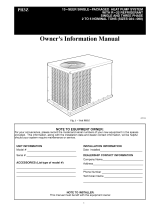Carrier TCSNAC01 is a non-programmable thermostat for either air conditioning (AC) or heat pump (HP) systems. Models are available for AC systems with 1-stage cooling and 1-stage heating as well as HP systems with 1-stage cooling and 2-stage heating. The thermostat can be used to control a single-speed heat pump or an air conditioner with a 2-stage furnace or fan coil. Software Option 5 allows the user to select between HP and AC operation, with the thermostat coming configured from the factory as a heat pump thermostat.
Carrier TCSNAC01 is a non-programmable thermostat for either air conditioning (AC) or heat pump (HP) systems. Models are available for AC systems with 1-stage cooling and 1-stage heating as well as HP systems with 1-stage cooling and 2-stage heating. The thermostat can be used to control a single-speed heat pump or an air conditioner with a 2-stage furnace or fan coil. Software Option 5 allows the user to select between HP and AC operation, with the thermostat coming configured from the factory as a heat pump thermostat.










-
 1
1
-
 2
2
-
 3
3
-
 4
4
-
 5
5
-
 6
6
-
 7
7
-
 8
8
-
 9
9
-
 10
10
Carrier TCSNAC01 is a non-programmable thermostat for either air conditioning (AC) or heat pump (HP) systems. Models are available for AC systems with 1-stage cooling and 1-stage heating as well as HP systems with 1-stage cooling and 2-stage heating. The thermostat can be used to control a single-speed heat pump or an air conditioner with a 2-stage furnace or fan coil. Software Option 5 allows the user to select between HP and AC operation, with the thermostat coming configured from the factory as a heat pump thermostat.
Ask a question and I''ll find the answer in the document
Finding information in a document is now easier with AI
Related papers
-
Carrier A07050 Installation Instructions Manual
-
Carrier Thermostat Installation, Start-Up, And Operating Instructions Manual
-
Carrier Thermostat User manual
-
Bryant T6-PHP User manual
-
Carrier TC-NAC01 Owner's manual
-
Bryant T6-PHP User manual
-
Carrier TP-PRH-A User manual
-
Carrier TB-PHP User manual
-
Carrier 38QRR/40QAQ Owner's manual
-
Bryant A07049 User manual
Other documents
-
Bryant TSTATBBNAC01-C User manual
-
Bryant 657A User manual
-
 Payne PH3ZNA042000AA Owner's manual
Payne PH3ZNA042000AA Owner's manual
-
Dometic 3313194 Series Operating Instructions Manual
-
Dometic 3313194 Series Operating Instructions Manual
-
Bryant 598A User manual
-
Dometic 3313192.XXX Cool Furnace 3313193.XXX Cool Furnace Heat Pump 3313194.XXX Cool Furnace Heat Strip Operating instructions
-
Friedrich RT2 User manual
-
Bryant Puron Refrigerant Two-Speed User manual
-
Voyager ACTH12 Owner's manual










